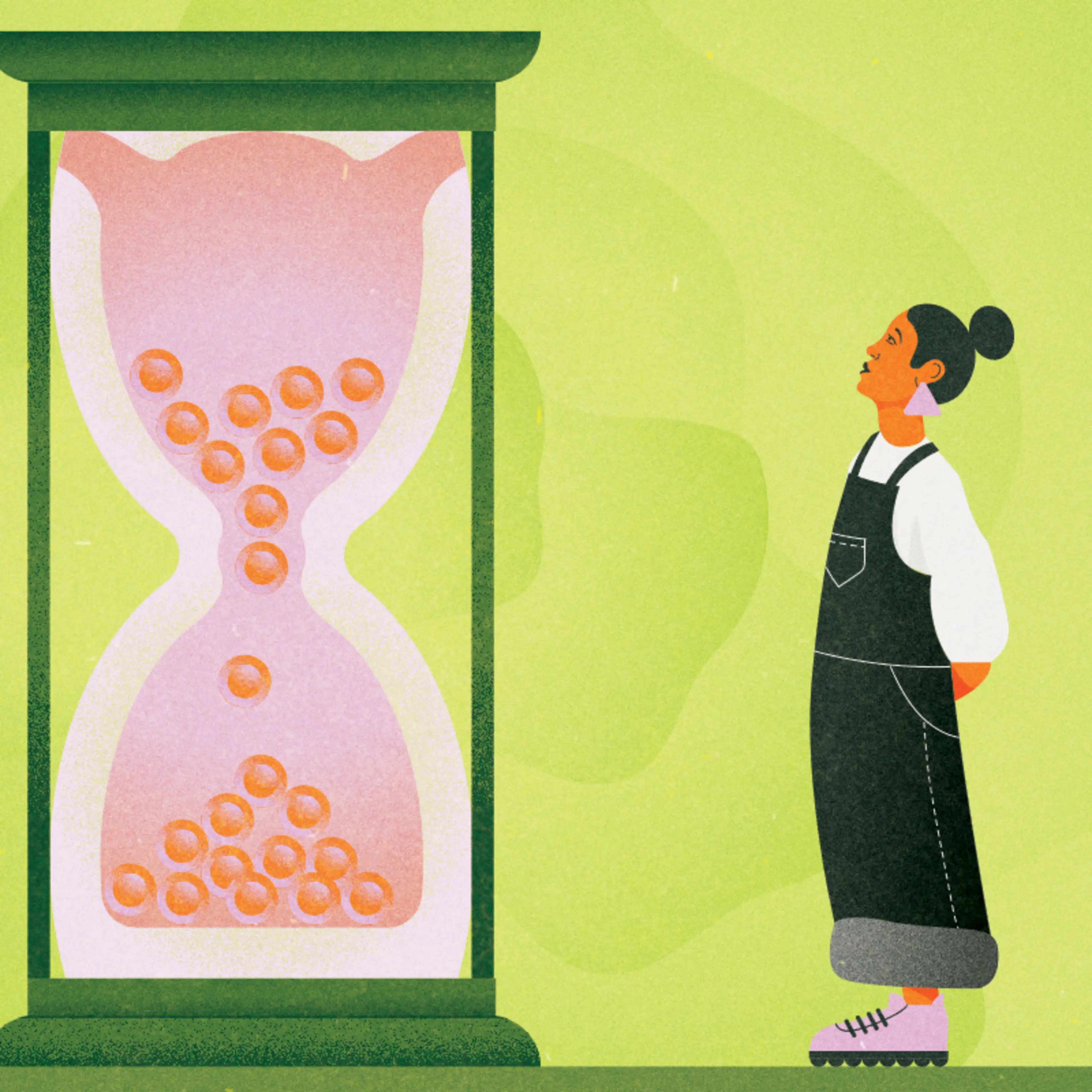At my first appointment at the fertility clinic, I got some great news. My doctor didn’t see anything preventing me from getting pregnant—my ovaries were working like champs and I was ovulating regularly—so she said I was a good candidate for intrauterine insemination (IUI). I knew this procedure was a lot cheaper and less invasive than IVF. As someone planning to be a single mother, spending less money and bypassing all the shots that I knew were involved in IVF sounded excellent. I was excited to get started as soon as possible.
What I quickly learned is that, while IUI has a lot of benefits when it comes to fertility treatments, it also has a downside: a success rate of 5-20%, fairly comparable to getting pregnant from sex. I ended up being in the majority. After three rounds of IUI without so much as a blip on a pregnancy test, my doctor advised switching to in-vitro fertilization (IVF) for a better chance of conceiving. (Spoiler alert: it worked—I got pregnant after my first embryo transfer!)
If you’re just getting started with fertility treatments, it’s important to understand IUI as it’s often the first intervention doctors recommend. (Though it’s not for everyone. Some people will jump immediately to IVF or will take a different approach altogether.) If you’re wondering if IUI is right for you, or if you’re gearing up for your first IUI, here’s what you need to know.
What Is IUI?
IUI is a method of getting sperm into the uterus during ovulation, usually with some medication to make it more effective. You can think of it as a much more sophisticated and exact turkey baster.
While most fertility procedures like egg retrieval and IVF must be done with a reproductive endocrinologist at a fertility clinic, IUI is less involved, so some ob-gyns will perform the procedure out of their own offices.
Who Should Consider This Procedure?
People will opt for IUI for a variety of reasons: single parents or same-sex couples using donor sperm, women who don’t ovulate (they will be given medication to induce ovulation1 during IUI), men with low sperm motility, and anyone with unexplained infertility (which is up to a third of all people who struggle with infertility). Some insurances also require attempting a few rounds of IUI before they will provide coverage for IVF (though insurance coverage for most fertility procedures is still quite rare).
While many will start with IUI before moving on to IVF, some patients may skip this step altogether and move straight to the second and more involved procedure. Since genetic testing of embryos is usually involved in the IVF process, those with hereditary genetic conditions or those who are older and thus more at risk for producing eggs with chromosomal abnormalities might opt to go straight to the more thorough IVF. Others choose to jump straight to IVF because of its higher success rate, though it’s important to note that it’s also more invasive and expensive.
In my case, I started with IUI as it was the protocol my fertility clinic and my insurance company set for me since I didn’t have any obvious reasons I couldn’t get pregnant. I was hoping I could save money through the procedure, and, at the time, my insurance required that I do three rounds of IUI before I could get coverage for IVF (a policy they have since done away with).
Preparing for an IUI
When it comes to fertility procedures, IUI is definitely the more relaxed of the options in terms of how time-consuming and intense the lead-up to procedure day is. Between day 1 and day 3 of your period, you’ll have an ultrasound at your clinic or doctor’s office to check out your follicles and make sure you don’t have any cysts.
Then, leading up to ovulation and your procedure day, you likely will take an oral medication like Letrozole that tells your body to release more than one egg. The medications help boost your odds of the IUI working. Although there is a risk of twins with IUI2 because of this part of the procedure, it’s not something doctors say you should worry too much about. During this time, you’ll have another ultrasound to check how your ovaries are responding to the medication.
As you get closer to ovulation, you’ll start testing your urine with ovulation test strips once a day—and it’s important to test at the same time each day. These strips are looking for luteinizing hormone, a sign you’re about to ovulate. Your doctor may also have you inject medication to induce ovulation—a “trigger shot”—particularly if your cycles are irregular or if they need to control the precise timing of the procedure.
Pro tip: Ovulation tests come in two forms: ones that show results with two lines and those that show a smiley face. The latter are more user-friendly but also quite a bit more expensive. Because luteinizing hormone is a gradient, test strips can be somewhat stressful to decipher—is that line pink enough to indicate ovulation, or could it be pinker? I found it helpful (and cost-effective) to test with the two-line strips and then “check my work” with the smiley face strips when I thought I had a positive.
Once you get a positive test, you’ll call your doctor’s office to schedule your IUI. If you do a trigger shot, you’ll go in exactly 36 hours after your shot.
When it comes to sperm, you’ll need to make sure that everything is lined up before the IUI procedure. If you’re using fresh sperm from a partner or known donor, your doctor’s office will tell you the exact timing, but keep in mind that the sample will need to be washed and concentrated before it can be used, so advanced planning is necessary. If you’re using frozen sperm, it will need to be shipped to the clinic a few days before the procedure (ask your clinic for cutoff times), and will be thawed day-of.
If your first IUI is not successful, the doctor will likely adjust your medication doses before your next round. It is also possible to do an IUI without medication, if that is something that feels right to you, though it is extremely rare.
IUI Day
While the steps to getting to the big day may seem a little involved, the good news is that the IUI procedure is fairly quick and painless—it’s a lot like your annual exam. You’ll be able to drive yourself to and from the appointment as there’s no anesthesia involved, though you may choose to bring someone along for good vibes.
During the procedure, your doctor will insert a speculum and feed a catheter through the cervix and into your uterus. They will then inject washed and concentrated sperm into your uterus. That part takes just a few minutes, and then you lie on your back for 15 minutes. You may feel some light cramping.
And that’s it! You’re done. Now comes the dreaded two-week wait where you have to act like you’re pregnant until you get confirmation from a pregnancy test via blood draw.
Success Rates for IUI
Now for the not-as-easy news. “Success rates are modest,” says Dr. Molly Quinn, reproductive endocrinologist at HRC Fertility. “Depending on the underlying diagnosis and age of the female undergoing treatment, success rates can be anywhere between 5-20% per month.” Dr. Quinn advises patients who start with IUI to prepare themselves to do more than one cycle and to have a planned stopping point to re-evaluate if this is the right path for them.
Dr. Jaime Knopman, a reproductive endocrinologist at CCRM Fertility of New York, points out that the only times the success rate of IUI is higher than 10% is for same-sex couples or for women who don’t ovulate—basically people who can’t get pregnant via sex. “I think it is important for couples to realize that while [medications] bump the success rate a bit, it is not a huge step up.”
“The other thing to remember is that with IUI you cannot genetically test the pregnancy,” Dr. Knopman says. “So while it may increase the chance of success, it does not decrease the chance for miscarriage.” This is why older people trying to conceive may choose to start the IVF process directly.
So, if you do start with IUI, when is it time to stop and move to another procedure? There’s no hard rule here—Dr. Knopman recommends a maximum of 3 IUI cycles before counseling someone to move to IVF (except in cases of same-sex couples under 35 or a woman who is only ovulating with the aid of the trigger shot.) On the other hand, Dr. Quinn says she might allow 4-6 attempts, depending on the underlying diagnosis. While the cut-off advice might vary between the doctors, both point to data that says the success rates of IUI plateau after 3 or 4 attempts.
Costs of IUI
Because it’s a simpler procedure, IUI is significantly cheaper than IVF—in the range of $500-$1,000 per attempt without insurance coverage, compared to $10,000+ for IVF without insurance.
If you are using donor sperm, that will absolutely be the most expensive part of the process — and it’s not covered by insurance. Donor sperm is usually over $1,000 per vial, with one vial needed per IUI attempt, plus the cost of shipping the frozen sample, which can range from $200-$400.
How to Mentally Prepare for IUI
My first IUI felt like a letdown—I was so excited to start trying to have a baby, I actually flew home early from a vacation. Then the procedure took five minutes and didn’t work. By the third IUI with no pregnancy, I truly started to feel like something was wrong with me. It’s important to remember that while success rates for IUI are not super high, they’re not zero either—my friend got pregnant on her second IUI attempt.
Fertility journeys are like that—there’s so much that’s left up to chance, and there’s no telling if one procedure or one tweak to a protocol will result in a pregnancy or a baby. I’ll never know if I could have eventually gotten pregnant with an IUI, but IVF is what allowed me to have my beautiful healthy baby.
So, as you prepare for IUI or whatever comes next in your fertility journey, remember that this is just one step. Approach it with cautious optimism, if that feels right to you. If it doesn’t work, it’s okay to feel disappointed, cry, and vent to your friends. But remember that for most people, there are more options out there that might lead to success.











